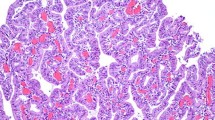Summary
Seventeen gastric carcinomas (intestinal n=12; diffuse n=1; mixed type n=4) and one Barrett's carcinoma were prospectively studied by immunohistochemistry for the expression of different keratin polypeptides and of the brush border markers villin, sucrase isomaltase and aminopeptidase N. All carcinomas expressed the keratin polypeptides 8, 18, and 19 and were stained by the broad specific keratin antibody KL1, irrespective of histologic type. Keratin 7, however, was expressed in only one carcinoma in most tumor cells and in two further carcinomas in some tumor cells. Thus, specific differentiation of the various histologic types of gastric carcinoma does not seem to be aided by the use of keratin antibodies. Villin was positive in 80% of the tumors and sucrase isomaltase and aminopeptidase N were positive in 67% respectively with no obvious histologic difference. The frequent positivity of the brush border markers, usually typical for intestinal epithelium, reflects the high degree of intestinal differentiation of gastric carcinomas, but again does not seem to be associated with a particular histologic type.[/p]
Zusammenfassung
Siebzehn Magenkarzinome (intestinal n=12; diffus n=1; Mischtyp n=4) und ein BarrettKarzinom wurden prospektiv hinsichtlich der Expression verschiedener Keratinpolypeptide sowie der Bürsten-saummarker Villin, Sucrase Isomaltase and Aminopeptidase N immunfluoreszenzmikroskopisch untersucht. Unabhängig vom histologischen Typ exprimierten alle Karzinome die Keratinpolypeptide 8, 18 and 19 and reagierten mit dem breit spezifischen Keratinantikbrper KL1. Das Keratin 7 hingegen wurde nur in einem Karzinom von nahezu allen Tumorzellen and bei zwei weiteren Karzinomen nur von einigen Tumorzellen exprimiert. Die weitergehende Differenzierung der verschiedenen hi stologischen Typen des Magenkarzinoms ist mit Hilfe der Keratinantikörper nicht m6glich. Villin war in 80% aller Karzinome and Sucrase Isomaltase and Aminopeptidase N waren in je 67%, wiederum ohne histologiespezifische Unterschiede, positiv. Die Nachweisbarkeit der Bürstensaummarker, charakteristisches Kennzeichen des intestinalen Epithels, verdeutlicht das hohe Maß der intestinalen Differenzierung der Magenkarzinome, ohne daß eine Zuordnung zu bestimmten histologischen Typen möglich erscheint.[/p]
Similar content being viewed by others
Literatur
Altmannsberger M, Weber K, Hölscher A, Schauer A, Osborn M (1982) Antibodies to intermediate filaments as diagnostic tools. Lab Invest 46:520–526
Borchard F, Sons HU (1985) Klassifizierung des Magenkarzinoms aus pathologisch-anatomischer Sicht. Therapiewoche 35:161–169
Bretscher A, Weber K (1979) Villin: the major microfilament-associated protein of the intestinal microvillus. Proc Natl Acad Sci USA 76:2321–2325
Bretscher A, Osborn M, Wehland J, Weber K (1981) Villin associates with specific microfilamentous structures as seen by immunofluorescence microscopy on tissue sections and cells microinjected with villin. Exp Cell Res 135:213–219
Debris E, Moll R, Franke WW Weber K, Osborn M (1984) Immunohistochemical distinction of human carcinomas by cytokeratin typing with monoclonal antibodies. Am J Pathol 114:121–130
Hauri HP, Sterchi EE, Bienz D, Fransen JAM, Marxer A (1985) Expression and intracellular transport of microvillus membrane hydrolases in human intestinal epithelial cells. J Cell Biol 101: 838–851
Hermanek P (1982) Chirurgische Pathologic - TNM-System. Langenbecks Arch Chir 358:57–63
Hermanek P (1987) TNM - Klassifikation maligner Tumoren -Magen. In: Hermanek P, Scheibe O, Spiessl B, Wagner G (Hrsg) UICC - TNM - Klassifikation maligner Tumoren. 4. Aufl. Springer, Berlin Heidelberg New York London Paris Tokyo, S 45–48
Jähne J, Meyer HJ, Wittekind C, Pichlmayr R (1989) Immunhistochemische Untersuchungen zum Magenkarzinom - Eine Studie am Primärtumor and den Lymphknotenmetastasen im Hinblick auf das tumorbiologische Verhalten. Langenbecks Arch Chir Suppl, Chir Forum, 503–506
Lauren P (1965) The two histological main types of gastric carcinoma: diffuse and so-called intestinal-type carcinoma. Acta Pathol Microbiol Scand 64:31–49
Lauren P (1967) Histochemical study on enzyme distribution in diffuse and intestinal-type gastric carcinoma. Acta Pathol Microbiol Scand [Suppl] 187:62
Moll R, Franke WW Schiller DL, Geiger B, Krepler R (1982) The catalogue of human cytokeratins: patterns of expression in normal epithelia, tumors and cultured cells. Cell 31:11–24
Moll R, Krepler R, Franke WW (1983) Complex cytokeratin polypeptide patterns observed in certain human carcinomas. Differentiation 23:256–269
Moll R, Robine S, Dudouet B, Louvard D (1987) Villin: a cytoskeletal protein and a differentiation marker expressed in some human adenocarcinomas. Virchows Arch B 54:155–169
Osborn M, Weber K (1983) Tumor diagnosis by intermediate filament typing: a novel tool for surgical pathology. Lab Invest 48:372–394
Osborn M, Lessen van G, Weber K, Klöppel G, Altmannsberger M (1986) Differential diagnosis of gastrointestinal carcinomas by using monoclonal antibodies specific for individual keratin polypeptides. Lab Invest 55:497–504
Osborn M, Mazzoleni G, Santini D, Marrano D, Martinelli G, Weber K (1988) Villin, intestinal brush border hydrolases and keratin polypeptides in intestinal metaplasia and gastric cancer; an immunohistologic study emphasizing the different degrees of intestinal and gastric differentiation in signet ring cell carcinomas. Virchows Arch A Pathol Anat 413:303–312
Ramaekers F, Huysmans A, Schaart G, Moesker O, Vooijs P (1987) Tissue distribution of keratin 7 as monitored by a monoclonal antibody. Exp Cell Res 170:235–249
Robine S, Huet C, Moll R, Sahuquillo-Merino C, Coudrier E, Zweibaum A, Louvard D (1985) Can villin be used to identify malignant digestive epithelial cells? Proc Natl Acad Sci USA 82:8488–8492
Santini D, Bazzochi F, Mazzoleni G, Ricci M, Viti G, Marrano D, Martinelli G (1987) Signetring cells in advanced gastric cancer. Acta Pathol Microbiol Immunol Scand Sect A 95:225–231
Skinner JM, Whitehead R (1982) Tumor markers in carcinoma and premalignant states of the stomach in humans. Eur J Cancer Clin Oncol 18:227–235
Tatematsu M, Furihata C, Katsuyama T, Miki K, Honda H, Konishi Y, Ito N (1986) Gastric and intestinal phenotypic expressions of human signet ring cell carcinomas revealed by their biochemistry, mucin histochemistry, and ultrastructure. Cancer Res 46:4866–4872
Wang HH, Antonioli DA, Goldman H (1986) Comparative features of esophageal and gastric adenocarcinomas: recent changes in type and frequency. Hum Pathol 17:482–487
Author information
Authors and Affiliations
Rights and permissions
About this article
Cite this article
Jähne, J., Osborne, M., Meyer, H.J. et al. Ermöglichen immunologische Marker eine Differenzierung zwischen den histologischen Typen des Magenkarzinoms?. Langenbecks Arch Chir 375, 135–140 (1990). https://doi.org/10.1007/BF00206805
Received:
Issue Date:
DOI: https://doi.org/10.1007/BF00206805




